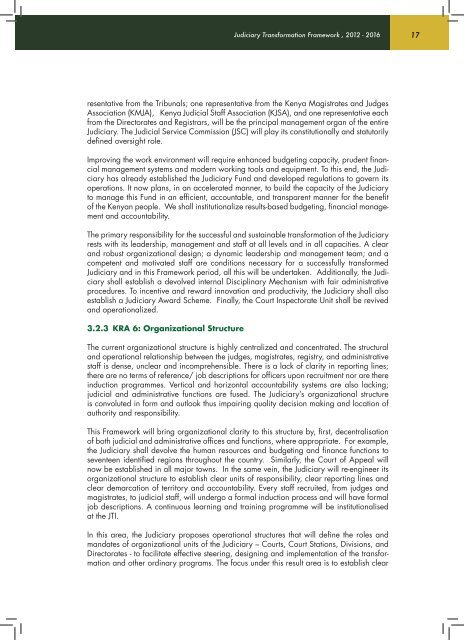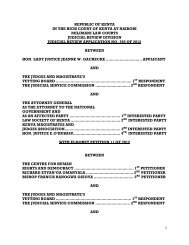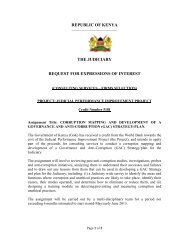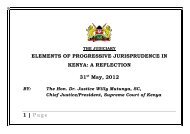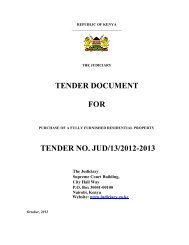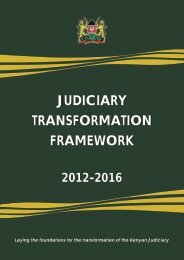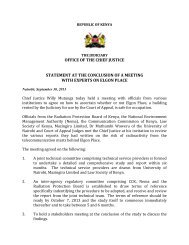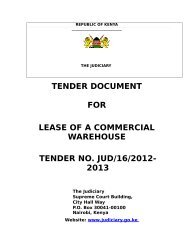judiciary transformation framework 2012-2016 - The Judiciary
judiciary transformation framework 2012-2016 - The Judiciary
judiciary transformation framework 2012-2016 - The Judiciary
You also want an ePaper? Increase the reach of your titles
YUMPU automatically turns print PDFs into web optimized ePapers that Google loves.
<strong>Judiciary</strong> Transformation Framework , <strong>2012</strong> - <strong>2016</strong> 17<br />
resentative from the Tribunals; one representative from the Kenya Magistrates and Judges<br />
Association (KMJA), Kenya Judicial Staff Association (KJSA), and one representative each<br />
from the Directorates and Registrars, will be the principal management organ of the entire<br />
<strong>Judiciary</strong>. <strong>The</strong> Judicial Service Commission (JSC) will play its constitutionally and statutorily<br />
defined oversight role.<br />
Improving the work environment will require enhanced budgeting capacity, prudent financial<br />
management systems and modern working tools and equipment. To this end, the <strong>Judiciary</strong><br />
has already established the <strong>Judiciary</strong> Fund and developed regulations to govern its<br />
operations. It now plans, in an accelerated manner, to build the capacity of the <strong>Judiciary</strong><br />
to manage this Fund in an efficient, accountable, and transparent manner for the benefit<br />
of the Kenyan people. We shall institutionalize results-based budgeting, financial management<br />
and accountability.<br />
<strong>The</strong> primary responsibility for the successful and sustainable <strong>transformation</strong> of the <strong>Judiciary</strong><br />
rests with its leadership, management and staff at all levels and in all capacities. A clear<br />
and robust organizational design; a dynamic leadership and management team; and a<br />
competent and motivated staff are conditions necessary for a successfully transformed<br />
<strong>Judiciary</strong> and in this Framework period, all this will be undertaken. Additionally, the <strong>Judiciary</strong><br />
shall establish a devolved internal Disciplinary Mechanism with fair administrative<br />
procedures. To incentive and reward innovation and productivity, the <strong>Judiciary</strong> shall also<br />
establish a <strong>Judiciary</strong> Award Scheme. Finally, the Court Inspectorate Unit shall be revived<br />
and operationalized.<br />
3.2.3 KRA 6: Organizational Structure<br />
<strong>The</strong> current organizational structure is highly centralized and concentrated. <strong>The</strong> structural<br />
and operational relationship between the judges, magistrates, registry, and administrative<br />
staff is dense, unclear and incomprehensible. <strong>The</strong>re is a lack of clarity in reporting lines;<br />
there are no terms of reference/ job descriptions for officers upon recruitment nor are there<br />
induction programmes. Vertical and horizontal accountability systems are also lacking;<br />
judicial and administrative functions are fused. <strong>The</strong> <strong>Judiciary</strong>’s organizational structure<br />
is convoluted in form and outlook thus impairing quality decision making and location of<br />
authority and responsibility.<br />
This Framework will bring organizational clarity to this structure by, first, decentralisation<br />
of both judicial and administrative offices and functions, where appropriate. For example,<br />
the <strong>Judiciary</strong> shall devolve the human resources and budgeting and finance functions to<br />
seventeen identified regions throughout the country. Similarly, the Court of Appeal will<br />
now be established in all major towns. In the same vein, the <strong>Judiciary</strong> will re-engineer its<br />
organizational structure to establish clear units of responsibility, clear reporting lines and<br />
clear demarcation of territory and accountability. Every staff recruited, from judges and<br />
magistrates, to judicial staff, will undergo a formal induction process and will have formal<br />
job descriptions. A continuous learning and training programme will be institutionalised<br />
at the JTI.<br />
In this area, the <strong>Judiciary</strong> proposes operational structures that will define the roles and<br />
mandates of organizational units of the <strong>Judiciary</strong> – Courts, Court Stations, Divisions, and<br />
Directorates - to facilitate effective steering, designing and implementation of the <strong>transformation</strong><br />
and other ordinary programs. <strong>The</strong> focus under this result area is to establish clear


